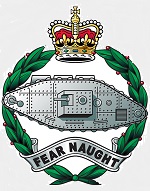Dragon DRR60570 British Churchill Mk. IV Infantry Tank - 4th Battalion, Grenadier Guards, France, 1944 (1:72 Scale)
"Victory at all costs, victory in spite of all terror, victory however long and hard the road may be; for without victory there is no survival."
- British Prime Minister Winston Churchill
 The "Churchill" began life as a 1939 requirement that envisaged a return to trench-warfare, and was therefore slow and heavily armored like the Russian KV-1 series. That said, the final Churchill prototype was much lighter than had first been thought acceptable, although it still resembled a World War I tank in appearance. Rushed into production at a time when a cross-channel invasion seemed imminent, it suffered early reliability problems and was not fully introduced until 1943. Early combat experience during the ill-fated Dieppe raid in 1942 was disappointing, but the vehicle proved more mobile in the rough terrain of North Africa. The tank excelled in its specialized variants, which include the AVRE, Crocodile flamethrower tank, bridgelayer and more. In fact, it wasn't until the 1960s that the last Churchill was finally retired.
The "Churchill" began life as a 1939 requirement that envisaged a return to trench-warfare, and was therefore slow and heavily armored like the Russian KV-1 series. That said, the final Churchill prototype was much lighter than had first been thought acceptable, although it still resembled a World War I tank in appearance. Rushed into production at a time when a cross-channel invasion seemed imminent, it suffered early reliability problems and was not fully introduced until 1943. Early combat experience during the ill-fated Dieppe raid in 1942 was disappointing, but the vehicle proved more mobile in the rough terrain of North Africa. The tank excelled in its specialized variants, which include the AVRE, Crocodile flamethrower tank, bridgelayer and more. In fact, it wasn't until the 1960s that the last Churchill was finally retired.
Pictured here is a 1:72 scale replica of a British Churchill Mk. IV infantry tank that was attached to the 4th Battalion, Grenadier Guards, then deployed to France during 1944.
Sold Out!
Dimensions:
Length: 4-inches
Width: 1-1/2-inches
Release Date: January 2013
Historical Account: "The Grenadier Guards" - During the Second World War the regiment was expanded to six service battalions, with the re-raising of the 4th Battalion, and the establishment of the 5th and 6th Battalions. The Grenadier Guards' first involvement in the war came in the early stages of the fighting when all three regular battalions were sent to France in late 1939 as part of the British Expeditionary Force. As the BEF was pushed back by the German blitzkrieg, these battalions played a considerable role in maintaining the British Army's reputation during the withdrawal phase of the campaign before being themselves evacuated from Dunkirk. After this they returned to the United Kingdom where they undertook defensive duties in anticipation of a possible invasion. Later, in 1941, there was a need to increase the number of armoured and motorized units in the British Army and as a result the 2nd and 4th Battalions were re-equipped with tanks, while the 1st Battalion was motorized. They subsequently served in the Guards Armoured Division in Western Europe in 1944-45. The 3rd, 5th and 6th Battalions also served in North Africa, where they fought significant battles in the Medjez-el-Bab and along the Mareth Line, and in Italy at Salerno, Monte Camino, Anzio, and along the Gothic Line. Throughout the course of the conflict, two Grenadiers received the Victoria Cross.
In June 1945, following the end of hostilities, the 2nd and 4th Battalions gave up their tanks and returned to the infantry role. The regiment returned to three battalions at this time, with the 4th and 5th Battalions being disbanded along with the 6th which had been removed from the order of battle before the end of the war. Initially, they were employed on occupation duties in Germany, however, the 3rd Battalion was deployed shortly afterwards to Palestine where they attempted to keep the peace until May 1948 when they were replaced by 1st Battalion. Further deployments came to Malaya in 1949, Tripoli in 1951 and Cyprus in 1956. In 1960, shortly after returning from Cyprus, the 3rd Battalion paraded for the last time and was subsequently placed in suspended animation. In order to maintain the battalion's customs and traditions, one of its companies, the Inkerman Company, was incorporated into the 1st Battalion.





 Excellent Service and Selection
Excellent Service and Selection 





![USMC Boeing Harrier II AV-8B Jump Jet - VMA-542 "Tigers", Marine Corps Air Station Cherry Point, North Carolina, 2016 [Low-Vis Scheme] (1:72 Scale)](http://cdn4.volusion.store/qh9e9-jdqv9/v/vspfiles/photos/HA2621-1.jpg?v-cache=1740197136)

![Star Trek Klingon Goroth's Transport [With Collector Magazine]](http://cdn4.volusion.store/qh9e9-jdqv9/v/vspfiles/photos/EMST0071-1.jpg?v-cache=1740197136)
